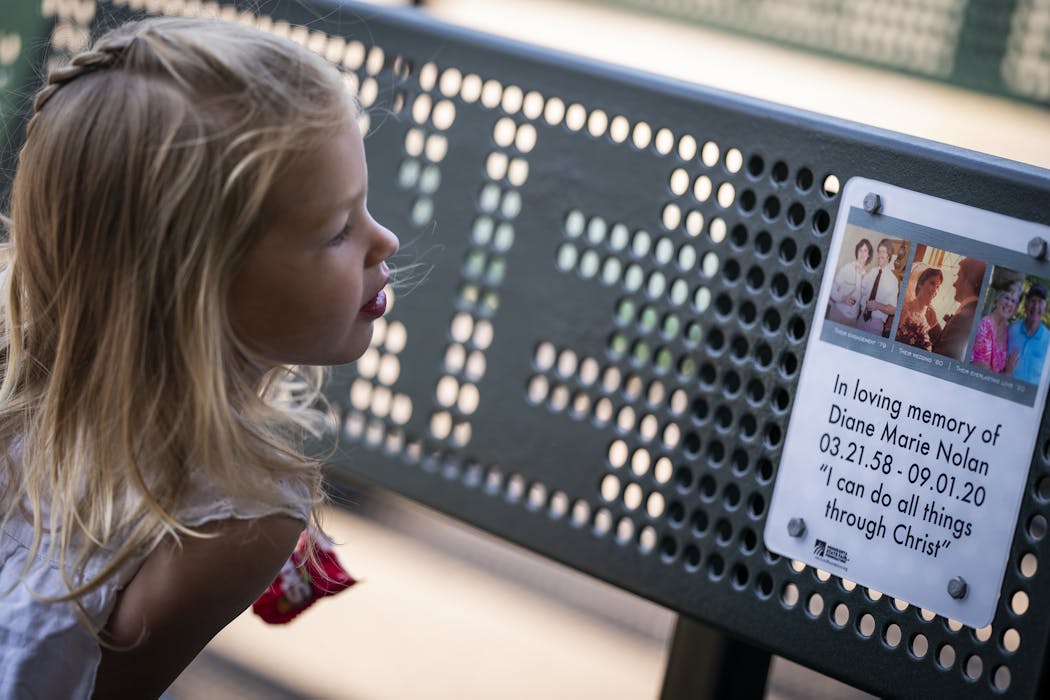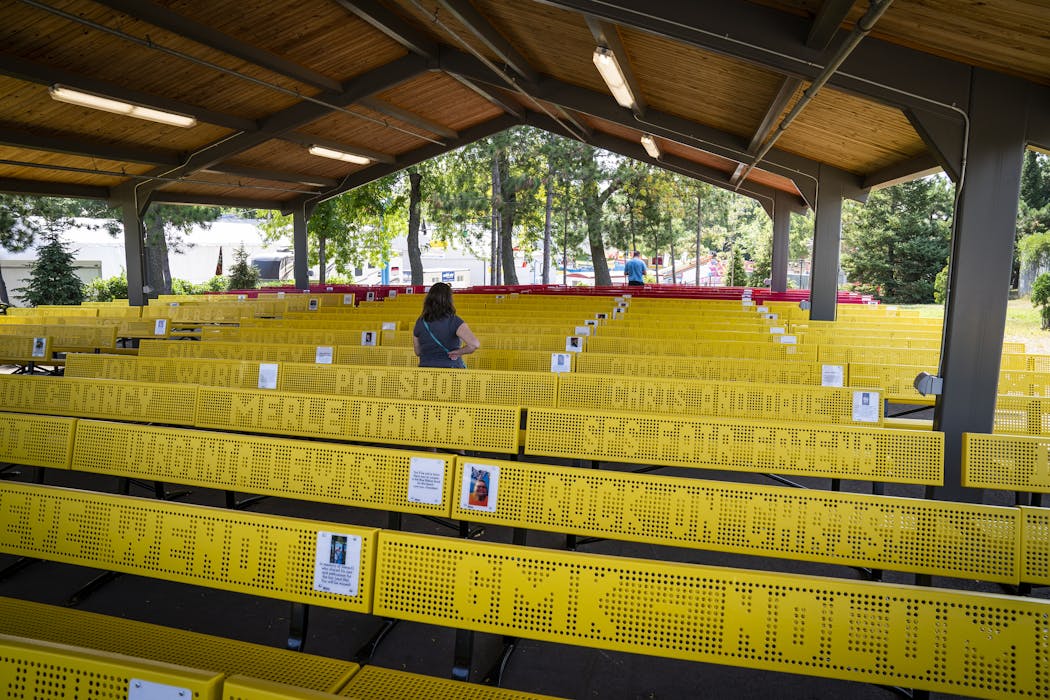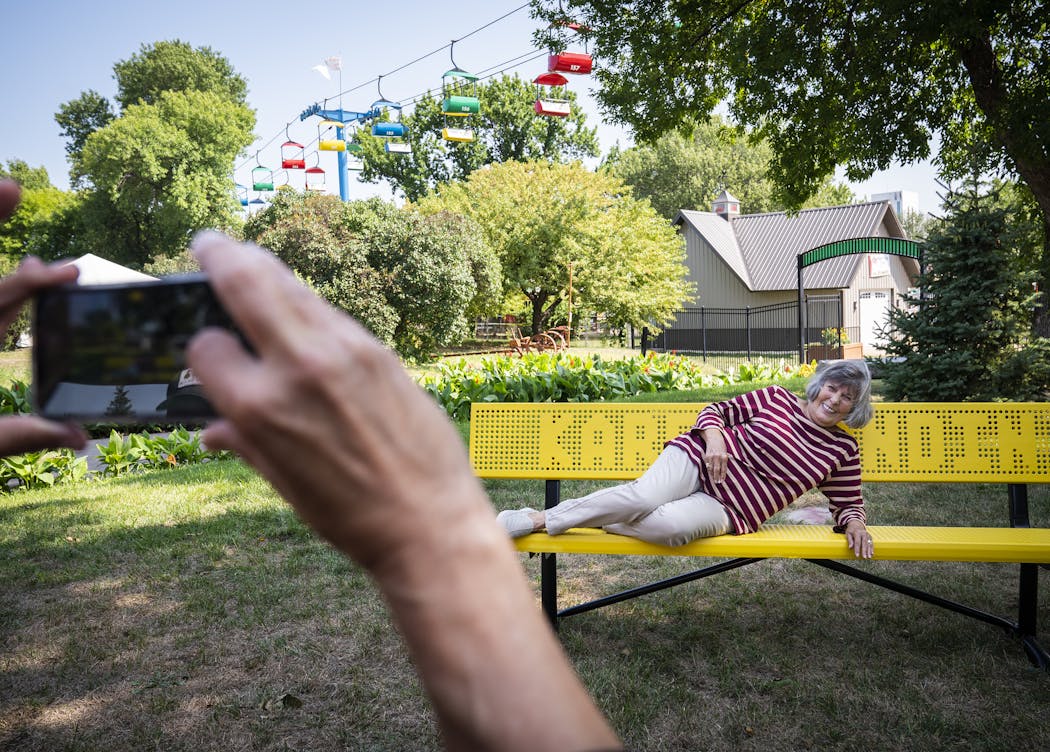Of all the words that could describe the Minnesota State Fair, "reverent" wouldn't top the list.
But it was with obvious reverence that members of the Elmajri family approached a red metal bench displayed on the fairgrounds. Personalized with the words "Rafa's Respite," the bench had been purchased by the family to honor their patriarch, Rafa Elmajri, who died of Lewy body disease in April 2020.
"He would have come to the fair even that day if he could have," said his oldest daughter, Aisha Robinson. "One year, he volunteered at the Dairy Barn just so he could be here more."
Elmajri arrived in Minnesota from his native Libya in the 1970s to pursue a doctorate at the University of Minnesota, where he met his future wife. As they raised their four children, the environmental scientist became a fair fan.
While he gamely went on thrill rides with his daughters in their teenage years and stood in line for ears of roasted corn, what he loved most about the annual All-American event was the people watching.
"The bench will be a place for people to relax, take a break," said his widow, Diane. "He needed that the last few times he came to the fair, as his disease progressed."
Begun 15 years ago by the State Fair Foundation to raise funds to beautify the fairgrounds, there are currently 1,500 memorial benches throughout the fairgrounds, giving fairgoers much needed seating — and giving families a unique way to honor loved ones, often posthumously.
But because seeing a personalized bench for the first time can be emotional for grieving family and friends, the foundation began inviting families to see the benches, which can be commissioned for $2,500 each, before opening day.
"They need time with their bench when no one is sitting on it," said the foundation's executive director, Mary Chung. "We keep it simple," Chung said of the viewing event. "There's no formal presentation. We provide them with bottles of water and a box of Kleenex."
Each bench carries the name of a fair fan and has an accompanying plaque with a few lines that often recount the person's particular connection to the fair.
Among this year's honorees are an exhibitor of Hereford cattle, a champion baker, a lover of cheese curds, a rider of Ye Old Mill and a fairgoer known for saying, "Oh, isn't dat cute?"
Jim Nolan, his two children and granddaughter came to see the bench dedicated to his wife, Diane, who died last September at age 62 from a pulmonary embolism.
His grief remains fresh. Mopping his eyes with a tissue, Nolan's voice broke when he talked about the Hastings couple's many State Fair experiences: sharing a blooming onion, applauding the Oak Ridge Boys, lugging home two buckets with attached brushes, perfect for washing their cars, purchased from a grandstand hawker.
Affixed to the green "Diane and Jim" bench is a plaque with Diane's birth and death dates and three photos of the couple — their engagement in 1979, a wedding portrait and a recent picture captioned, "Their everlasting love."
"I think she would be pleased with this. I hope she's looking down at us," he said. "I'll come and sit and think about the good times. We had a lot of them."
Touchstone vs. tombstone
The benches are what could technically be called cenotaphs, defined as "a memorial to honor a person whose remains are elsewhere," according to Prof. Michael LuBrant, director of the Program of Mortuary Science at the University of Minnesota.
In our transient society, LuBrant said, the traditional family graveyard has lost its meaning for many people who live — and die — far from their roots. Add to that the dramatic rise in cremation and the scattering of ashes, which leaves many mourners without a specific spot where a loved one's remains or cremains are present.
For some families, a memorial like a bench is a touchstone that replaces a tombstone.
"There are new rituals and rites but as our hearts grieve, finding a meaningful way to memorialize the beloved dead really does matter," he said.
LuBrant notes that in the past, families placed memorial benches in cemeteries as a place to rest and reflect while visiting a grave. Today, such benches are more likely found in parks or overlooking lakes, rivers or landscapes favored by the lost loved one, whose name is typically engraved on it.
"The name is important, for what do we have but our name and our story?" he said. "Grief is highly personal and there's been a broadening of ways survivors feel connected. The place becomes symbolic and even sacred for next of kin."
A gift of comfort
The benches can help alleviate grief even when its rawness eases.
In 2014, Jenny and Doug Meslow of Stillwater purchased two memorial benches to honor their son, who died at age 19 from bone cancer.
"As a family we're big fairgoers," said Jenny. "His last summer he couldn't walk because of the tumor in his ankle and he lamented that he wouldn't be able to go. I said, 'The hell you're not!' We got a scooter and we did it. I'm so glad we have that memory of that last fair together."
The Meslows said their son's passion for the fair made it "a no-brainer" to invite friends and family to join them in donating for a bench.
"We were overwhelmed how the money poured in, so we bought two," said Doug. "He used the names Pete and Peter interchangeably, so we have one bench for each name."
Fair benches are painted in bright shades of red, blue, yellow and green, with each color corresponding to a quadrant of the fairgrounds. They're stowed away each winter. When fair season rolls around, each bench lands in a different spot in its section.
The Meslows have made an annual tradition of racing around the fairgrounds to find the exact location of their benches — one blue (their son's favorite color), the other yellow (an homage to his Livestrong rubber bracelet). Throughout the 12-day run of the fair, they savor photos texted from friends who share evidence of their ritual sit with Pete (or Peter).
"One year one of the benches was by the Skyride and we remembered doing that together. Another year it was by the Haunted House, our family meeting spot," said Doug. "The different locations remind us of our experiences."
Pete would be 35 now, but Jenny said he remains "frozen in time" as a teenager. During the fair they allow themselves the bittersweet exercise of contemplating what might have been.
"We sit on the bench and talk about what he would be doing. We hope other people who loved him do that, too," said Jenny. "Having lost a child, what I hope the most is that people remember that Peter lived. The bench is such a gift. It comforts me."
Surprising the superfan
Not all of the new benches were greeted with tears.
Karen Landin whooped with glee when she saw the bench with her name on it. Her family surprised her with it, after telling her they were meeting at the fairgrounds for a four-generation family picnic.
"I was so touched that they thought enough of me to do this," she said.
A retired secretary from Hudson, Wis., Landin, 78, was a preschooler when she first walked through the State Fair gates in the 1940s, holding her father's hand. Until the cancellation in 2020, she never missed a year, often attending four or five days, "from 7 a.m. until after the fireworks," making memories with her children, then their children and now with her great-grandchildren.
"When my dad died, I mentioned that I wished I would have bought him a bench because he so loved the fair and he raised me to love the fair, too," she said.
Hearing that, Landin's daughter and brother conspired to personalize a bench to honor her and the man they called Papa.
Landin knows the majority of the benches bear names of people who are deceased and admits she's tickled to get the chance to experience her bench here and now.
"Someday I'll be buried in a plot in a country cemetery near Menomonie, but the kids will have more fun visiting me at the fair," she said. "I don't plan on it happening anytime soon but I like the idea of my name being here even when I'm not."
Kevyn Burger is a Minneapolis-based freelance broadcaster and writer.
Retrial of Harvey Weinstein unlikely to occur soon, if ever, experts say
Today in History: April 27, Magellan killed in the Philippines
The summer after Barbenheimer and the strikes, Hollywood charts a new course





